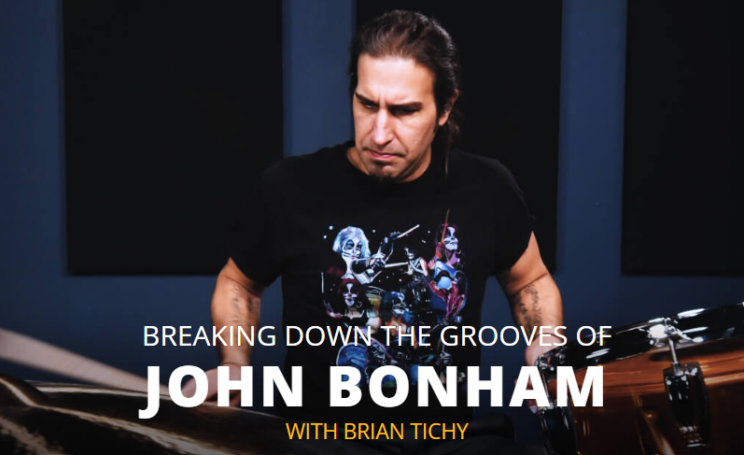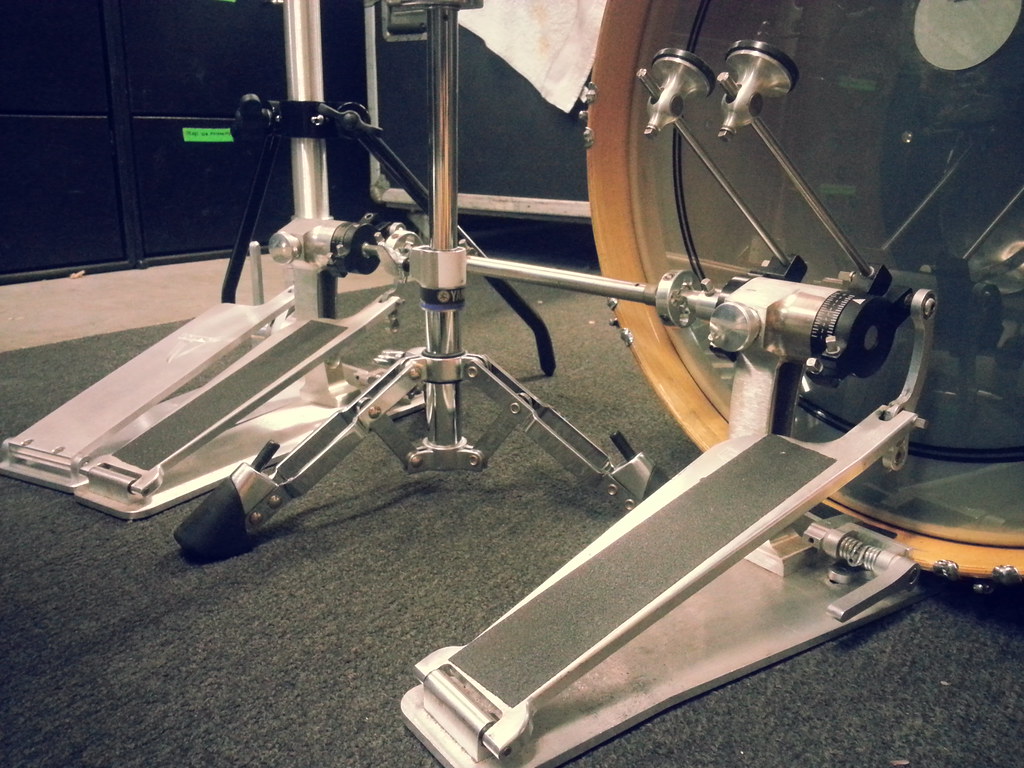How to Drum Like John Bonham – 10 Tips

Every rock drummer should spend some time learning what made Bonham sound like Bonham. While his genius cannot be explained merely in technical terms, some of his favorite techniques can be mimicked, readapted, and reinvented by any dedicated drummer.
John Bonham’s iconic playing style was characterized by his signature triplets, recognizable drum grooves, innovative rhythmic approach, and Ludwig drums setup.
Bonzo became one of rock and roll’s most renowned instrumentalists by the time Led Zeppelin released their debut album. He was considered to be one of the most influential, and uncopyable, rock drummers ever.
This article is sponsored by Drumeo, which I consider to be the best resource for learning drums online. They have released a much-watch youtube video “The Genius Of John Bonham”, along with free sheet music for Bonzo’s parts in the video. They also released a great FREE Drumeo series that breaks down 10 of Led Zeppelin’s most famous grooves.

Contents
- 1. What made John Bonham so special?
- 2. Explore the subdivisions
- 3. Get John Bonham’s kit
- 4. Learn the Bonham Triplets
- 5. Emphasize the last note of each triplet
- 6. Practice triplets using crossovers
- 7. Get behind the beat
- 8. Play single-footed bass drum doubles
- 9. Don’t be afraid to let loose
- 10. Experiment with odd time signatures
- Conclusion
1. What made John Bonham so special?
John Bonham is widely regarded as one of the best rock drummers of all time. His playing was a mix of feel, energy, flawless technique, and cleverness. Unquestionably, he was a natural talent, but also a virtuoso and a masterful composer of grooves. In other words, Bonham had it all.
In “The Genius of Jonh Bonham,” Drumeo describes how “playing with power” and being “ferocious” helped to set the legendary Led Zeppelin drummer apart from every other instrumentalist at the time—or up until now. The video is also filled with great tips on how to drum like Bonham.
In terms of style, Bonham earned his place in the history of rock by bringing many influences from jazz and R&B into rock and roll and blues. His well-known liking of drummers such as Gene Krupa and Max Roach allowed him to understand that, apart from power, rock music also relies on feel. Bonham’s non-metronomic approach to rhythm was far from commonplace back when Led Zeppelin released their debut album.
Hard as it seems, it’s not completely impossible to drum (almost) like the great John Bonham. Below, you can find some helpful tips on how to do so.
2. Explore the subdivisions
There’s a lot of power in exploring the subdivisions of the beat, and Bonham knew this better than any other rock drummer at his time. Never satisfied with playing bland quarter and eight notes, the Led Zeppelin drummer was known for his fluid approach to beat measures, which was likely inspired by his jazz and R&B idols.
Bonham’s use of syncopation is notable, and a big part of what made him sound so unique. While he could rock a plain 4/4 beat as well as anyone else, he had a knack for coming up with grooves that were both unusual (making extensive use of tuplets and beats placed on the and) and strangely catchy.
In the aforementioned Drumeo video on “The Genius of Jonh Bonham,” Bonham’s “monumental grooves” are described as being “so recognizable” that they’re instinctively familiar to anyone, “even if they didn’t play drums.” To see the sheet music for all of Bonzo’s parts featured in the video, visit: https://www.drumeo.com/beat/john-bonham-drum-genius/
Bonham’s talent for exploring the subdivisions of the beat is best exemplified by his signature triplets. The famous “Bonham Triplets” are perhaps the technique people most commonly associate with the Led Zeppelin drummer.
3. Get John Bonham’s kit
Good drumming isn’t in the drums—it’s in the drummer. Nevertheless, knowing how John Bonham used to set up his instrument is a great tip for starting to sound like him.
For the vast majority of his career, the Led Zeppelin drummer relied solely on equipment from Ludwig. Even though his approach to the instrument changed extensively over the years, his standard kit was comprised of two floor toms, two mounted crash cymbals, a hi-hat, and a large bass drum with a mounted tom and ride cymbal. Bonham’s standard kit was similar to Buddy Rich’s, who was one of his main influences.
Bonham achieved his characteristic snare sound by placing a double-ply coated batter head on the skins and getting a noticeable medium-frequency resonance out of it. He also used a felt strip on the batter side of his bass drums to muffle the kick.
Bonham’s fondness for Ludwig’s drums can be partly responsible for how powerful his instrument sounded. In the ’60s, Ludwig’s drums were considered to be louder than the main alternative (Premiere’s drums). Loudness made a big difference in a studio and live-show context at the time.
Naturally, having a finely-tuned set of drums from Ludwig isn’t enough to drum like John Bonham. However, it’s a great way of starting to capture his unique tone and rehearsing some of his signature grooves.
4. Learn the Bonham Triplets
The Bonham Triplets are so quintessential to Bonham’s playing style that they even come with their own myth. Legend has it that the Led Zeppelin drummer invented the Bonham Triplets after mishearing Vanilla Fudge’s drummer Carmine Appice playing while touring. He thought that he was just copying Appice; however, Appice himself later admitted that he’d never played anything like the Bonham Triplets before.
Rock and roll trivia aside, the Bonham Triplets effect can be achieved by playing the bass drum in the tri and let of a regular three-beat tri-po-let division (i.e., triplet division). In this video, the American musician and record producer Brian Tichy explains what’s the best way of rehearsing the Bonham Triplets.
As stated by Tichy, it’s preferable to start with a constant rhythm of eight-note hi-hats with a snare on the 2 and 4. Only then one should introduce the bass-drum triplets—as slowly as needed.
Perfection takes practice, so it’s always helpful to count on the natural impulse of the leg to play Bonham’s signature triplets. Tichy recommends using the toe first and then following with the leg to make the most of the momentum placed on the second note of the triplet. Speaking of which…
5. Emphasize the last note of each triplet
While the signature Bonham Triplets are played on beat subdivisions of three (meaning each measure is counted as tri-po-let instead of as one-two-three-four), Bonham also loved to use 16th-note sextuplets in his fills (meaning that each beat was divided by six instead of three).
Bonham’s powerful fills were also based on his habit of emphasizing the last note of each tuplet played on the bass drum. This technique places increased tension on the first beat of the next measure, creating a pull-forward type of effect. Again, it is strongly influenced by legendary drummers such as Rich and Krupa.
6. Practice triplets using crossovers
While Bonham’s grooves were brightly composed, his approach to drumming was mainly physical. Known for his speed and energy, “Bonzo” played the drums in pretty much any way one can play the drums. However, his use of crossovers was particularly prevalent.
Bonham’s crossover technique was, yet again, inspired by the great jazz drummers he most admired. He used the Max Roach’s RLRK (Right-Left-Right-Kick) rudiment a lot, especially for performing his signature triplets. So, why not keep up with the Led Zeppelin drummer and practice the Bonham Triplets using RLRK crossovers?
Mastering triplets using the RLRK rudiment is one of the best ways of starting to drum like Bonham. Begin at a slow tempo and try to play faster and faster. Soon enough, the RLRK rudiment will help your body to interiorize the Bonham Triplets.
In the meantime, learn 10 of Led Zeppelin’s most famous grooves in this FREE Drumeo series!
7. Get behind the beat
In music, the expression “playing behind the beat” refers to when a drummer plays a bit later than the other musicians, creating a “fall off the beat” type of effect. Nowadays, this kind of drum playing is sometimes referred to as drunk drumming. However, many years before the “drunk feel” came into the picture, geniuses of the like of Bonham were already getting behind the beat.
How does one play behind the beat? In a nutshell, it’s about waiting the right amount of milliseconds to start accompanying the rest of the band. It’s about drumming without copying the metronome, but also without losing track of the song’s groove.
While it’s possible to write a behind-the-beat groove in a piece of sheet music using as many subdivisions as necessary, the art of playing behind the beat has more to do with feeling than with counting measures. In jazz, it is what musicians sometimes refer to as the “swing,” i.e., the ability a drummer has to stretch and shorten tempo as he or she pleases.
8. Play single-footed bass drum doubles
There’s no denying that Bonham was known for his powerful playing. But what used to set the Led Zeppelin drummer apart was also his natural groove. At some level, playing single-footed bass drum doubles was a big part of what made “Bonzo” sound so unique.
To drum like one of rock’s greatest, practice bass drum doubles using a single-footed pedal. Bass drum doubles in the style of the Bonham Triplets are great, but there are other alternatives to explore. The important thing is to put that double-footed pedal aside for a moment.
While double-footed pedals are great for getting a lot of energy out of the bass drum, they’re not as precise when it comes to groove. Bonham got a great combination of power and groove out of his standard kit because he used a large bass drum to get the necessary thump while playing with a single-footed pedal for control and precision.
9. Don’t be afraid to let loose
Bonham was a “monster.” While touring with Led Zeppelin, he loved to perform improvised drum solos while his bandmates rested. And while nobody knows where the seemingly endless energy of the “Bonzo” came from, many rock enthusiasts have analyzed Bonham’s iconic solos in detail to learn more about his playing style.
The technical illations one can take from just a couple of minutes of Boham’s soloing are such that it would be impossible to list them all. But if there’s a lesson to draw from Boham’s improvisational skills, it’s that it’s never a bad idea to let loose.
The Led Zeppelin drummer was exemplary when it comes to exploring new approaches, as seen in the many videos in which he plays the drum kit using his hands (not the bongos, but the actual kit)!
Another great example of Bonham’s prowess in trying wild new things is seen in a song appropriately titled “Four Sticks,” in which he played using two sticks in each hand.
10. Experiment with odd time signatures
With Bonham at the wheel, Led Zeppelin were masters at switching between time signatures in the middle of a song (as seen in “Black Dog,” which goes from 4/4 to 3/4 to 5/4).
Bonham’s elastic approach to tempo is also seen in the seminal “Kashmir,” in which “Bonzo” rocks a steady 4/4 beat even though all the other instruments are playing at a 3/4 time signature:
Either way, trying to come up with catchy grooves based on odd time signatures is one of the best methods for learning how to sound like Bonham.
Be sure to check out the FREE Drumeo series that breaks down 10 of Led Zeppelin’s most famous grooves.

Conclusion
Bonzo has gone down as one of the most iconic and recognizable drummers in music history. It’s worth experimenting with his signature grooves and techniques to stretch your skills as a drummer. Though don’t take it too seriously, the late Led Zeppelin great should be an influence on your own playing, not someone you should try to mimic exactly!
John Bonham image credit Dina Regine, CC BY-SA 2.0, via Wikimedia Commons







